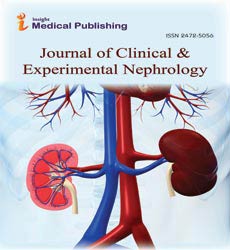Glomerulonephritis: An In-Depth Look at Kidney Inflammation and It's Impact
Afonso Jose
Jose A (2024) Glomerulonephritis: An In-Depth Look at Kidney Inflammation and Its Impact. J Clin Exp Nephrol Vol.9 No.6: 290.
Published Date: 2024-12-16DOI10.36648/2472-5056.9.6.290
Afonso Jose*
1Department of Medicine, Oporto University, Porto, Portugal
- *Corresponding Author:
- Afonso Jose
Department of Medicine, Oporto University, Porto, Portugal
E-mail: joseafonso@po.pr
Received date: November 30, 2024, Manuscript No. IPJCEN-24-19999; Editor assigned date: December 02, 2024, PreQC No. IPJCEN-24-19999 (PQ); Reviewed date: December 16, 2024, QC No. IPJCEN-24-19999; Revised date: December 23, 2024, Manuscript No. IPJCEN-24-19999 (R); Published date: December 30, 2024, DOI: 10.36648/2472-5056.9.6.290
Citation: Jose A (2024) Glomerulonephritis: An In-Depth Look at Kidney In lamma ion and It's Impact. J Clin Exp Nephrol Vol.9 No.6: 290.
Description
Glomerulonephritis (GN) designates a category of disorders marked by inflammation of the glomeruli, which are the small filtering units of the kidneys. Such inflammation can lead to diminished kidney function, varying from mild to severe and is frequently linked to various clinical symptoms including hematuria, proteinuri and edema. GN can be classified as either acute or chronic, with different underlying causes and results. Comprehending its pathophysiology, clinical manifestation, diagnostic strategy and therapeutic options is essential for effectively managing the condition. Primary glomerulonephritis arises when the glomeruli are directly impacted by an intrinsic injury, usually attributed to immune-mediated processes. This surround conditions such as IgA nephropathy, Focal Segmental Glomerulosclerosis (FSGS) and membranous nephropathy. In these disorders, the immune system erroneously targets the glomerular structures, causing inflammation and injury. Secondary glomerulonephritis is due to systemic diseases like Systemic Lupus Erythematosus (SLE), vasculitis and infections such as hepatitis B or C. In these instances, the glomerular injury results from systemic inflammation or the deposition of immune complexes, which can result in extensive damage to the kidney's filtering systems. At the cellular level, immune complexes, which consist of clusters of antibodies and antigens, accumulate in the glomeruli. This triggers an inflammatory reaction, involving the recruitment of immune cells such as neutrophils and macrophages.
Clinical presentation
The clinical signs of glomerulonephritis vary based on the underlying cause and the extent of kidney involvement. Acute types of GN frequently manifest with the classic triad of hematuria, proteinuria and edema. Hematuria, or the presence of blood in the urine, serves as an important hallmark, which can be evident to the naked eye or discovered only under a microscope. Proteinuria, referring to an elevated level of protein in the urine, may produce foamy urine and in severe cases, it can lead to nephrotic syndrome. Edema, particularly periorbital and lower extremity swelling, constitutes another prevalent sign of GN. The kidneys' failure to eliminate excess fluid results in fluid retention, leading to swelling in different areas of the body. Hypertension is often noted in patients with GN due to the kidneys' compromised ability to manage fluid balance and sodium. sodium. In certain situations, GN may present without symptoms, especially during the initial phases of the disease. This is especially true for particular forms of chronic glomerulonephritis, where the damage advances gradually over time without obvious symptoms until kidney function significantly deteriorates.
Diagnosis: The identification of glomerulonephritis necessitates combination of clinical assessment, laboratory evaluations and imaging studies. The initial evaluation generally involves a urine analysis, which can disclose hematuria and proteinuria. A 24 h urine collection or urine protein-to-creatinine ratio might assist in quantifying proteinuria, which is vital for evaluating the severity of the disease. Blood tests are also vital in the diagnosis of GN. The serum creatinine level and Glomerular Filtration Rate (GFR) are frequently utilized to evaluate kidney function. Increased creatinine levels and a diminished GFR indicate compromised kidney function, which is prevalent in later stages of glomerulonephritis. Serological tests are commonly conducted to uncover underlying factors of secondary glomerulonephritis. For instance, Antinuclear Antibodies (ANA) and anti-dsDNA antibodies are utilized to diagnose lupus nephritis, while assays for Antineutrophil Cytoplasmic Antibodies (ANCA) can assist in identifying vasculitis-related GN. In situations where an infection is suspected, tests for hepatitis B, C, or HIV may be requested.
Treatment
The management of glomerulonephritis is contingent upon the underlying cause, the severity of kidney involvement and the existence of complications. Acute instances of GN might necessitate hospitalization, particularly if there is considerable kidney impairment or the patient faces risks for complications such as renal failure. For immune-mediated GN, corticosteroids and immunosuppressive drugs like cyclophosphamide, azathioprine, or mycophenolate mofetil are typically employed. These medications aid in suppressing the immune response, thereby diminishing inflammation and averting further glomerular injury. In certain situations, plasma exchange might be utilized to eliminate circulating immune complexes or autoantibodies in conditions such as Rapidly Progressive Glomerulonephritis (RPGN). For secondary glomerulonephritis linked to systemic diseases, treatment emphasizes addressing the underlying issue. For example, in cases of lupus nephritis, managing disease activity with immunosuppressive agents and anti-inflammatory drugs is vital. In instances of infectionsrelated GN, suitable antimicrobial therapy is critical to tackle the underlying infection
Conclusion
Glomerulonephritis represents a heterogeneous and intricate group of kidney disorders that can considerably affect renal function. Comprehending the underlying mechanisms, clinical characteristics and treatment strategies is vital for early identification and effective management. While numerous forms of GN can be successfully treated with immunosuppressive therapies and symptomatic management, others might advance to chronic kidney disease and necessitate more intensive interventions. Ongoing research into the pathophysiology and treatment of glomerulonephritis holds promise for enhancing the outcomes for impacted patients.
Open Access Journals
- Aquaculture & Veterinary Science
- Chemistry & Chemical Sciences
- Clinical Sciences
- Engineering
- General Science
- Genetics & Molecular Biology
- Health Care & Nursing
- Immunology & Microbiology
- Materials Science
- Mathematics & Physics
- Medical Sciences
- Neurology & Psychiatry
- Oncology & Cancer Science
- Pharmaceutical Sciences
